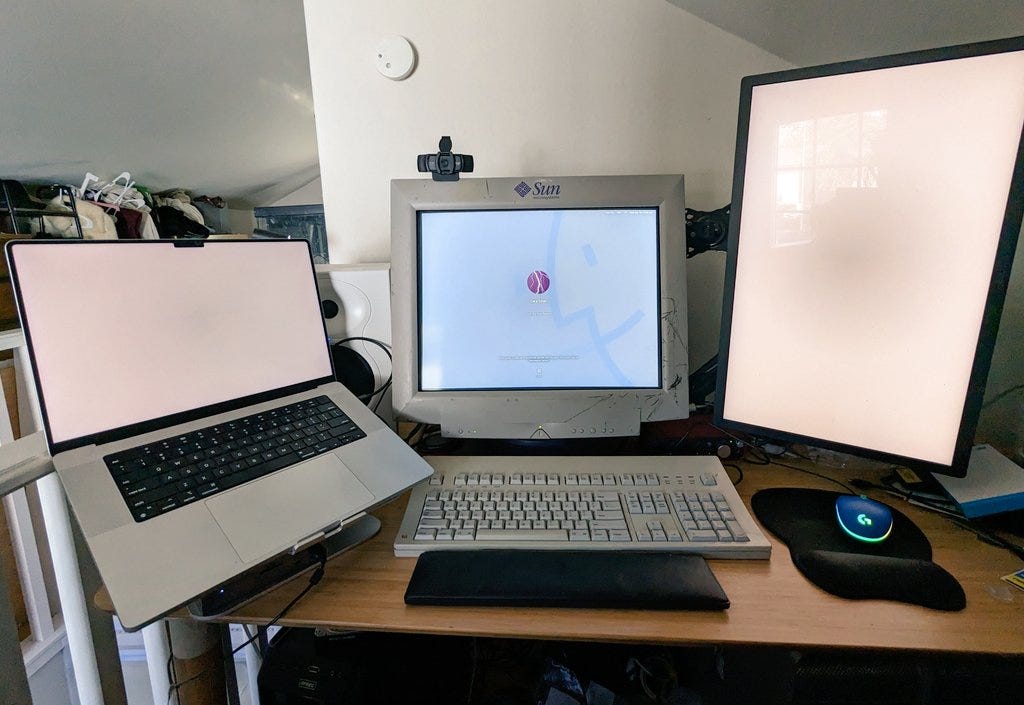On CRTs, And Other Forking Paths
Revisiting roads not taken
This Quadra 650 I’m typing on is almost too fast. Somehow, it feels zippier than the 630 it replaced, but given the near-identical specs, that’s probably just my imagination. The video card is objectively better though; I can turn up the resolution to 832x624 and everything seems small, distant, so much space to work with, and all of it clear and sharp.
I’ve been spending a lot of time thinking about old displays lately. Recently, I replaced my Dell LCD monitor with a Sun Microsystems CRT, capable of about the same vertical resolution, but cropped horizontally. I like the way CRTs display color, so much richer and more vibrant than anything but top-of-the-line OLEDs. Probably more accurate too, though I haven’t bothered to calibrate the Sun yet. Faster response times, more elegant contrast, there are plenty of reasons to use a CRT in 2023, though few do.
When most people think about technology, they imagine a line that moves forward, constantly. Even the complaints about it take this as a natural assumption: it moves too quickly, or it bypasses the vulnerable. But technology moves at different rates across different axes, and when it advances across one of them, it obscures its shortcomings on another. Technologists, or, more accurately, the bosses who direct technologists, make decisions about prioritizing certain characteristics of a technology, whether that’s ease of use, ease of manufacture, portability, fidelity, or a number of other concerns. When it comes to displays, in the mid-2000s, it became capable to produce LCDs that were smaller and lighter than most CRTs. People bought these displays in droves despite the fact that, even compared to low-end modern LCDs, they kind of looked like trash. But, they were more convenient to carry around, brighter, required less fuss.
Every morning, when I start my computer, I take a minute or two to calibrate convergence. The way a CRT works is that, inside the tube, there are beams for red, green, and blue light. These beams need to be directed to “converge” on a single point in order to get the color right, if they’re out of alignment even slightly, the image looks oddly blurry, smudged, in a way that’s difficult to put your finger on. Calibrating this, with a white crosshatched grid, is a little ritual that tells me the monitor is displaying things just as well as it possibly can for the day. It’s a way to get me and the machine started on the same page.
When Tim Berners-Lee famously published his paper on the Web in 1990, hypertext was already a teenager. ZOG had been in use on aircraft carriers for a decade, HyperCard was a successful product by Apple, and Ted Nelson was selling Xanadu to anyone who’d listen. But now, when we think of hypertext, we think of links embedded in a page’s text, authored by a single writer (a webmaster, to use 90s terminology). But Intermedia, a hypertext system running on Apple’s Unix distribution, A/UX, stored links outside the text, and allowed each user to author their own links by marking up the text with annotations. These links were bidirectional, meaning that every link to a child page would link back to its parent, and could also be made to link to multiple places, via a simple menu. Editing and permissions were also built into the system, features which are difficult to reason about for even experienced web developers today. Berners-Lee’s system won out not because it was advancing the state of the art, but because it was practical and accessible.
Thirty years on, we’re all supposed to marvel at it, as if it were a massive leap forward, when, in truth, it was just a compromise that caught on.
Back to displays. Showing anything on a CRT is an analog process: a VGA cable carries signals for the various colors that need to be displayed, and over it, the monitor and the computer decide to transmit those signals at a certain rate. In order to get the smoothest motion possible and avoid headaches, the rate should be set as high as the hardware supports. In the early 2000s, there were CRTs made that could display resolutions higher than HD displays at refresh rates nearing 90Hz. A standard LCD these days will display at a rough equivalent of 60Hz, gaming panels can go up to 120. Last week, I fought with my series of adapters to try and push the refresh rate and resolution as high as possible, but due to strange behaviors in either the adapter or the modern graphics card on my computer, I fell far short of what the monitor was capable of. There was a point in 2004 where the average computer could display content on that monitor in a way that was noticeably better than what I can do today.
As time marches on, decisions are made, opportunities are foreclosed upon, and technology moves ever-forward. But the technology we have today reeks of decay and stagnation; Twitter is dying under the rule of an inept petty tyrant, Facebook tried in vain to make the Metaverse happen, TV manufacturers pushed 3D and failed, each successive generation of mobile phones is more boring than the last. Pair that with layoffs, bank runs, and tightening controls on labor, and it’s clear: the old world is dying.
I don’t know what comes next, but I've seen enough to say that this iteration of tech is a failure. If the road ahead of us is inevitably full of VCs and their lackeys hawking the next NFTs or cryptocurrency, we could do worse than look behind us and see what got left by the wayside as we marched headlong into this dead end. There might be some interesting things that, in our hurry, we left scattered on the side of the road.


